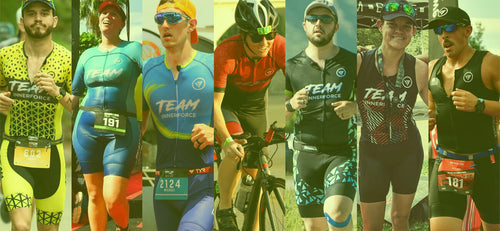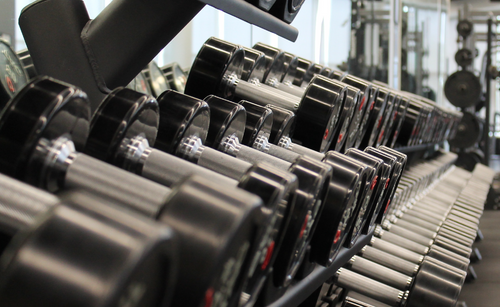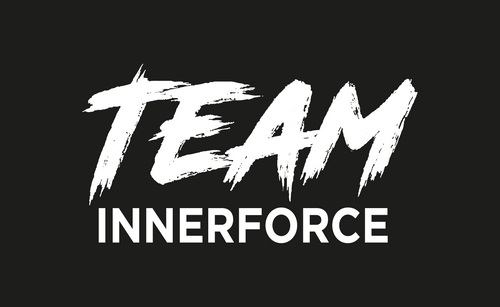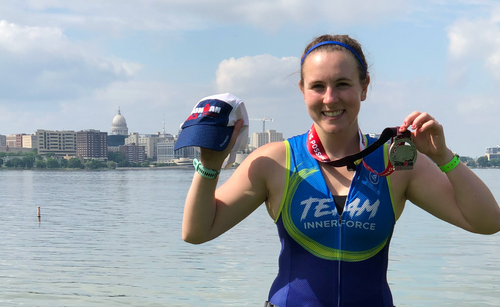How To Fuel For Endurance Events

It seems to me that endurance events sneak up on you like a kindly addiction. You start with the simple intention of becoming a ‘little bit fitter’ and head out for a 20-minute run three times a week. Before you know it you are poised at the starting line of a marathon wondering ‘how did I get here’?
At some point during the journey to becoming an endurance athlete, we will all hit the point where we need to consider fuelling up during the event, or training session. When we experience this for the first time it is quite a shock. Our bodies let us know in no uncertain terms that we need fuel. Our pace on the bike drops off a cliff, and we feel like we are peddling through sand. Our run grinds to a slow shuffle, and nothing our minds can say will force our stubborn bodies to respond. Some call this ‘the wall’ others know it as ‘bonking’, whatever you call it, it is a highly unpleasant feeling.
In this article we will look at when to fuel for a long training session, or event, as well as the options that are available. Generally speaking, any session that lasts over 90 minutes will require some form of fuelling. The main options are isotonic drinks, bars and gels but what works for you is a highly personal decision.
When Do You Need To Fuel?
Any session that lasts over 90 minutes will require you to fuel in some way. The reason behind this is that the body uses energy stores in a pre-set order: Glycogen, Carbohydrates and then fat. Glycogen is energy in its simplest form, and is stored in the muscles ready for instant use. The payment for this easy access is that is simply does not last for a long time. The body is limited to being able to store only 1,750 calories of glycogen for a 70kg athlete, after which point the stocks are depleted and the body moves onto burning stored carbohydrates.
If your usual cycling sessions are for one hour and you decide to move up to 90 minutes then you may notice a drop in energy levels towards the end of the ride. For me, it was always at around the 2-hour mark that my body would refuse to keep up even close to my previous average speed. The frustration of the body not responding to the requests of the mind led me to question what was going on, and the answer was clear; without fuel the body will slow down, no matter how strongly your mind argues the point.
Depending on the type of fuelling you opt for, the rules will differ slightly on exactly when you need to fill the tank. That said, you certainly want to be taking on some form of energy before you hit the 90-minute mark because it will take some time for the fuel to be digested and be ready to be used.
Should I Use Gels, Bars Or Drinks?
Now that you have identified the reason for hitting the wall, the decision comes to choose what you will use to fuel your longer sessions. The three main options are gels, bars and sports drinks.
Gels: The advantage of gels is that they are specifically designed for endurance athletes to deliver the most carbohydrates in the most efficient manner possible. There are a plethora of options out there, but to give you an idea here are the stats on GU Energy Gels:
Price: Approx. $10 for 6 sachets
Carbohydrates: 25g per sachet
Start working after: 5 minutes
Take one every: 35-40 minutes
Gels are compact, so they can fit easily in a pocket or race belt and there are a variety of flavors. Some also come with caffeine, which has been shown to benefit certain athletes in performance times.
Bars: There are many types of ‘energy bars’ on the market, and they are used for different effects. For endurance athletes we want those that are high in carbohydrates and low in protein as they will give a cleaner burn. Protein creates a waste product that needs to be flushed out by the kidneys, and this uses up precious fluids. Here are the stats on SIS bars:
Price: Approx. $22.70 for 12 sachets
Carbohydrates: 30g per bar
Start working after: 5 minutes
Take one every: 35-40 minutes
Sports drinks: Sports drinks are another option that many use in conjunction with bars and gels (just remember to take on plain water too or else you risk dehydration with some sports drinks). The obvious disadvantage is the size of these, but if you are an avid cyclist then you can easily pop an extra bottle holder on your bike and have one for water and one for a sports drink. Here are the stats on Accelerade from Pacific Health:
Price: Approx. $27 for 30 servings
Carbohydrates: 21g per serving
Start working after: 5 minutes
Take one every: gently sip continuously after 20-25 minutes
Final Thoughts
The best way to really know which fuel to take on is to do a little testing. Your digestive system will certainly be different to others, so while it is good to ask for advice, the proof of the pudding is in the eating. Don’t wait until race day to realize that the gels you have been hoarding actually give you crippling stomach cramps, use them during training sessions and work out which works best for you.
Written for Innerforce by Stewart Spiessens
Photos. @justin_lippert

It seems to me that endurance events sneak up on you like a kindly addiction. You start with the simple intention of becoming a ‘little bit fitter’ and head out for a 20-minute run three times a week. Before you know it you are poised at the starting line of a marathon wondering ‘how did I get here’?
At some point during the journey to becoming an endurance athlete, we will all hit the point where we need to consider fuelling up during the event, or training session. When we experience this for the first time it is quite a shock. Our bodies let us know in no uncertain terms that we need fuel. Our pace on the bike drops off a cliff, and we feel like we are peddling through sand. Our run grinds to a slow shuffle, and nothing our minds can say will force our stubborn bodies to respond. Some call this ‘the wall’ others know it as ‘bonking’, whatever you call it, it is a highly unpleasant feeling.
In this article we will look at when to fuel for a long training session, or event, as well as the options that are available. Generally speaking, any session that lasts over 90 minutes will require some form of fuelling. The main options are isotonic drinks, bars and gels but what works for you is a highly personal decision.
When Do You Need To Fuel?
Any session that lasts over 90 minutes will require you to fuel in some way. The reason behind this is that the body uses energy stores in a pre-set order: Glycogen, Carbohydrates and then fat. Glycogen is energy in its simplest form, and is stored in the muscles ready for instant use. The payment for this easy access is that is simply does not last for a long time. The body is limited to being able to store only 1,750 calories of glycogen for a 70kg athlete, after which point the stocks are depleted and the body moves onto burning stored carbohydrates.
If your usual cycling sessions are for one hour and you decide to move up to 90 minutes then you may notice a drop in energy levels towards the end of the ride. For me, it was always at around the 2-hour mark that my body would refuse to keep up even close to my previous average speed. The frustration of the body not responding to the requests of the mind led me to question what was going on, and the answer was clear; without fuel the body will slow down, no matter how strongly your mind argues the point.
Depending on the type of fuelling you opt for, the rules will differ slightly on exactly when you need to fill the tank. That said, you certainly want to be taking on some form of energy before you hit the 90-minute mark because it will take some time for the fuel to be digested and be ready to be used.
Should I Use Gels, Bars Or Drinks?
Now that you have identified the reason for hitting the wall, the decision comes to choose what you will use to fuel your longer sessions. The three main options are gels, bars and sports drinks.
Gels: The advantage of gels is that they are specifically designed for endurance athletes to deliver the most carbohydrates in the most efficient manner possible. There are a plethora of options out there, but to give you an idea here are the stats on GU Energy Gels:
Price: Approx. $10 for 6 sachets
Carbohydrates: 25g per sachet
Start working after: 5 minutes
Take one every: 35-40 minutes
Gels are compact, so they can fit easily in a pocket or race belt and there are a variety of flavors. Some also come with caffeine, which has been shown to benefit certain athletes in performance times.
Bars: There are many types of ‘energy bars’ on the market, and they are used for different effects. For endurance athletes we want those that are high in carbohydrates and low in protein as they will give a cleaner burn. Protein creates a waste product that needs to be flushed out by the kidneys, and this uses up precious fluids. Here are the stats on SIS bars:
Price: Approx. $22.70 for 12 sachets
Carbohydrates: 30g per bar
Start working after: 5 minutes
Take one every: 35-40 minutes
Sports drinks: Sports drinks are another option that many use in conjunction with bars and gels (just remember to take on plain water too or else you risk dehydration with some sports drinks). The obvious disadvantage is the size of these, but if you are an avid cyclist then you can easily pop an extra bottle holder on your bike and have one for water and one for a sports drink. Here are the stats on Accelerade from Pacific Health:
Price: Approx. $27 for 30 servings
Carbohydrates: 21g per serving
Start working after: 5 minutes
Take one every: gently sip continuously after 20-25 minutes
Final Thoughts
The best way to really know which fuel to take on is to do a little testing. Your digestive system will certainly be different to others, so while it is good to ask for advice, the proof of the pudding is in the eating. Don’t wait until race day to realize that the gels you have been hoarding actually give you crippling stomach cramps, use them during training sessions and work out which works best for you.
Written for Innerforce by Stewart Spiessens
Photos. @justin_lippert
SEE WHAT CUSTOM APPAREL LOOKS LIKE

GEAR UP
MORE FROM THE BLOG

Regional Leader: Team Innerforce 2020
Editor’s Note: The following is a compilation with some of the briefs stories of our Regionals Leaders Team Innerforce 2020...

Team Innerforce Strength Program
Disclaimer: This program may not be suited for everyone. Consult with your doctor or physical therapist before beginning this program...

Under the hood of Team Innerforce 2019
Editor's Note: The following is a compilation of recap notes from athletes from Team Innerforce 2019. They are the best...

No Beta Cells, No Problem
Doctors told me I couldn’t be an endurance athlete, and you would never guess by looking at me that I...



